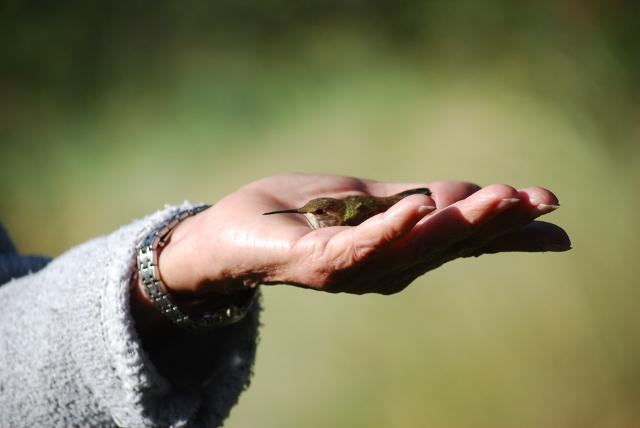
On a cool early morning in Idaho City, IBO Hummingbird Project Lead Jessica Pollock, Outreach and Education Director Heidi Ware, and their team showed a lucky group of bird watchers the art of hummingbird banding.
Homeowner Jennifer Alban, an avid bird watcher, moved to Idaho City in 2006. She has opened her property to the Intermountain Bird Observatory for the last four years.
“Hummingbirds are important pollinators in the ecosystem,” Alban noted.
Banding allows scientists to monitor three hummingbird species that use the Boise National Forest during the breeding and migration season – Black-chinned, Rufous and Calliope hummingbirds. Weather plays an important part in trapping, which is why the banding season occurs during early summer mornings. Sunrise begins the start of trapping. In fact, more birds are caught in the first three hours after sunrise.
Volunteer and IBO Board Member Dr. David Wike mans the nets that safely catch the hummingbirds. Wike is in his 20th season with IBO, and he enjoys the interaction with people young and old.
“It’s a privilege to do this and handle the birds,” said the retired physician, whose former career prepared him for the detailed and scientific work involved with bird banding. “There is a specific way to catch the birds in the nets and take them out. I enjoy teaching that to people. It is an intergenerational respect with all the IBO members. We all learn from one another.”
After being trapped, the birds are placed in a netted bag before the data collection begins. This process is done quickly, so there is little stress to the birds. Both Ware and Pollack weigh, measure and evaluate each bird, while graduate students record data.
“We are monitoring the abundance, breeding condition and success, and migratory timing of the birds,” said Ware. “This season has been different so far because the birds migrated back because of the early summer. We haven’t seen as many babies either, so that is another reason our research is so critical.”
Back at the banding station, each guest had an opportunity to release a hummingbird right out of the palm of his or her hand. The delight and wonder was evident on the volunteers’ faces. People from all generations enjoyed the experience and gained valuable knowledge. As one volunteer eloquently stated, “I get more from the IBO than I give.” Most visitors would certainly agree!
By: Pam Robbins
[slider id=”ibo-hummingbird-banding”]